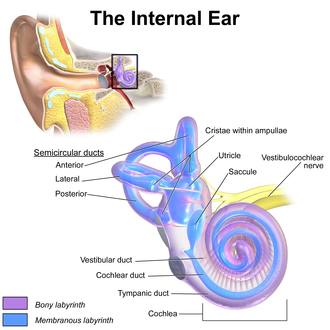What is BPPV?
Benign Paroxysmal Positional Vertigo – BPPV – is the most common vestibular disorder. Vertigo is the false sensation of spinning with altered positions of the head in relation to gravity. BPPV can be very debilitating and impacts on the quality of life of those who are affected.
It is associated with reduced activities of daily living, falls and depression. Although, BPPV is common, delays in diagnosis and inappropriate treatment still occurs. This is why it is important if you are experiencing these symptoms to be diagnosed by your health care professional.
There are three systems that we rely on to maintain our balance, the visual system (our eyes), the proprioceptive system (joints, muscles and skin) and the vestibular system (the inner ear).
These systems relay information to one another through various pathways which ultimately tells our brain if we are sitting, lying down or even standing on our heads!
The ear is an organ of hearing and balance, and consist of three main parts, the outer ear, middle ear and the inner ear. The inner ear plays a vital role in maintaining balance. There are three fluid-filled semicircular canals that detect rotation of the head in relation to gravity and are responsible for dynamic balance.
In BPPV there is a disruption in the inner ear. Calcium crystals that are normally embedded in the gel-like fluid in these semicircular canals, become dislodged and this alters sensation in the inner ear, sending false sensory information to the brain (and their balance buddies), leading to the perception of being dizzy.

Signs and Symptoms
“I got up out of bed and it felt as though the room was spinning”
“Every time I reach to get my mug from the top shelf, I feel like I’m going to fall over”
“I rolled over to turn my alarm off in bed, next thing I knew I felt a wave of dizziness and felt sick”
The feeling of dizziness occurs with altered movements of the head and the feeling of dizziness typically last approximately from 5 to 60 seconds.
Other symptoms are:
– Nausea
– Vomiting
– Feeling faint
– Visual disturbances.
Common descriptors of symptoms associated with the above are:
– Rolling in bed
– Tying up shoe laces
– Reaching overhead
Differential Diagnosis
While BPPV is the most common cause of vertigo, it has to be noted that there are other causes of dizziness. Diagnosis of your signs and symptoms should be made by your health care professional
Physiotherapy Intervention
Physiotherapy plays an important role in treating BPPV and can be corrected mechanically with Particle Repositioning Manoeuvres. Once your physiotherapist has determined the cause of your symptoms is BPPV, specific treatment manoeuvres can then be applied.
Amy Furler
References:
Bhattacharyya, N., Baugh, F, R., Orvidas, L., Barrs, D., Bronston, J, L., Cass, S., … Haidari, J. (2008). Clinical practice guideline: Benign paroxysmal positional vertigo. Otolaryngology – Head and Neck Surgery. 139 S47-S81. Doi: 10.1016/j.otohns.2008.08.02
Helminski, O, J., Zee, S, D., Janssen, I., & Hain, C, T. Effectiveness of particle repositioning maneuvers in the treatment of benign paroxysmal positioning vertigo: A systematic review. Physical Therapy 90(5) 663-678 doi: 10.2522/ptj.20090071


